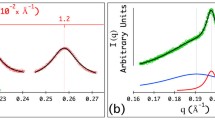Abstract
The dipole-dipole contribution to the energy of the pair interaction between DNA molecules has been calculated and analyzed. Rigid fragments of DNA, i.e., of a length of about the persistent length, which have discrete dipole moments of base pairs, are considered. For a given distance between the centers of mass of molecules, the energy of the dipole-dipole interaction is a function of three angular variables; the angles ϕ1 and ϕ2 between the central dipoles of both molecules and the z axis passing through the centers of the molecules, as well as the angle ξ between long axes of the molecules, are taken as these variables. It is shown that the dipole energy has minima when the mutual orientation of the molecules satisfies one of the following conditions: (i) ϕ1 = ϕ2 = 0 or (ii) ϕ1 = ϕ2 = π. The cholesteric twist angle ξ can be both positive and negative in dependence on the type of the minimum. For realistic cholesteric dispersion parameters, the dipole energy is only slightly lower than the experimentally known binding energy of the molecules in dispersion. The results allow the assumption that the dipole forces significantly affect the structure and other properties of DNA suspensions; in particular, they can lead to nontrivial texture phenomena, biaxial correlation, and multistability.
Similar content being viewed by others
References
T. Thomas and T. J. Thomas, Cell Mol. Life Sci. 58, 244 (2001).
L. van Dam, N. Korolev, and L. Nordenskiold, Nucleic Acids Res. 30, 419 (2002).
Yu. M. Evdokimov, V. I. Sal’yanov, B. V. Mkhedlishvili, et al., Sens. Sist. 13, 82 (1999).
E. Raspaud, D. Durand, and F. Livolant, Biophys. J. 88, 392 (2005).
V. A. Belyakov, V. P. Orlov, S. V. Semenov, et al., Liq. Cryst. 20, 777 (1996).
P. G. de Gennes and J. Prost, The Physics of Liquid Crystals, 2nd ed. (Clarendon, Oxford, 1993; Mir, Moscow, 1982).
A. A. Kornyshev and S. Leikin, J. Chem. Phys. 107, 3656 (1997).
A. A. Kornyshev and S. Leikin, Phys. Rev. E 62, 2576 (2000).
A. A. Kornyshev and S. Leikin, Phys. Rev. Lett. 84, 2537 (2001).
B. Samori, M. A. Osipov, I. Domini, and A. Bartolini, Int. J. Biol. Macromol. 15, 353 (1993).
Y. H. Kim, J. Phys. (Paris) 43, 559 (1982).
G. S. Manning, Biopolymers 19, 37 (1980).
J. Sponer, J. Leszcynski, and P. Hobza, Biopolymers 61, 3 (2002).
A. A. Kornyshev, D. J. Lee, S. Leikin, et al., Phys. Rev. Lett. 95, 148102 (2005).
Author information
Authors and Affiliations
Additional information
Original Russian Text © V.L. Golo, E.I. Kats, I.P. Kikot’, 2006, published in Pis’ma v Zhurnal Éksperimental’noĭ i Teoreticheskoĭ Fiziki, 2006, Vol. 84, No. 5, pp. 334–338.
Rights and permissions
About this article
Cite this article
Golo, V.L., Kats, E.I. & Kikot’, I.P. Effect of dipole forces on the structure of the liquid phases of DNA. Jetp Lett. 84, 275–279 (2006). https://doi.org/10.1134/S0021364006170103
Received:
Issue Date:
DOI: https://doi.org/10.1134/S0021364006170103




